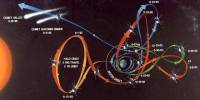The study of the behavior of electromagnetic radiation, particularly light, when the wavelength is equivalent to the size of optical components is known as quasioptics. Quasioptics is the study of the propagation of electromagnetic radiation in situations where the wavelength is comparable to the size of the optical components (e.g., lenses, mirrors, and apertures), and hence diffraction effects may become prominent.
Geometric optics may accurately represent the behavior of light in classical optics, when wavelengths are significantly less than the size of optical elements. When dealing with wavelengths of the same order of magnitude as the size of the optical elements, however, wave optics and diffraction effects become important.
It is widely used to explain the propagation of Gaussian beams with beam widths corresponding to wavelengths. In geometrical optics, the wavelength is modest in comparison to the relevant length scales.
Quasioptics is so named because it represents a transitional regime between traditional optics and electronics, and it is frequently used to describe signals in the far-infrared or terahertz regions of the electromagnetic spectrum. It is a condensed version of a more rigorous treatment of physical optics. Lower frequencies, such as millimeter wave, microwave, and even lower, can be used by quasi-optical systems.
Quasioptics is particularly important in millimeter-wave and submillimeter-wave optics, where wavelengths range from millimeters to submillimeters. It is also critical in the design and study of some types of optical systems, such as those used in radio astronomy or the development of modern communication systems operating in the millimeter-wave spectrum.
In quasioptics, researchers and engineers must frequently address diffraction, interference, and other wave phenomena that may not be as noticeable in traditional optical systems. This is especially important in circumstances where precise control of light is required, such as the design of micro-optical devices, diffraction-limited imaging systems, and other applications where the size of the components is comparable to the wavelength of the light being employed.
















